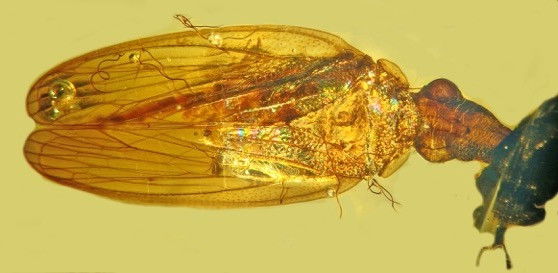Jump to a conclusion: OSU researcher IDs fossil insect as new genus, species of prodigious leaper, the froghopper

CORVALLIS, Ore. (KTVZ) – A fossil arthropod entombed in 100-million-year-old Burmese amber has been identified as a new genus and species of froghopper, known today as an insect with prodigious leaping ability in adulthood following a nymphal stage spent covered in a frothy fluid.
Oregon State University researcher George Poinar Jr., an international expert in using plant and animal life forms preserved in amber to learn about the biology and ecology of the distant past, and his co-author, Alex E. Brown, published the findings in the journal Life.
The authors categorized the new froghopper as Araeoanasillus leptosomus, from the Greek words for thin (araeos) and bristling hair (anasillos) in reference to fern hairs (trichomes) associated with the specimen.
The froghopper superfamily, Cercopoidea, contains five families that exist today – Cercopoidae, Aphrophoridae, Clastopteridae, Epipygidae and Machaerotidae – as well as the extinct families Cercopionidae, Procercopidae and Sinoalidae.
“Based on its diagnostic characteristics, our specimen seems to fall in the family Sinoalidae,” Poinar said.
Froghoppers are in the order Hemiptera. Known as “true bugs,” the Hemiptera order is made up of more than 80,000 species including cicadas, aphids, planthoppers, leafhoppers, bed bugs and shield bugs.
True bugs’ size varies widely, from as small as 1 millimeter to as large as 15 centimeters, but they all, except for some of the smaller males, have a similar arrangement of sucking mouthparts, Poinar said.
In its “spittlebug” form, an immature froghopper taps into a plant stem’s sap, sucks it in and then releases it from its rectum, the researcher explained. The spittlebug froths the extruded fluid – think cappuccino maker – and covers itself with the resulting slippery foam, which conceals it from predators like ants and also protects it from the parasitic wasps that like to lay eggs inside the spittlebug’s body.
In adulthood these small (generally around 1 centimeter long), brown bugs can spring forward up to 100 times their body length thanks to their powerful hind legs equipped with structures that flex like an archery bow and can exert force 400 times greater than their body weight.
Froghoppers feed on many types of plants and are found anywhere vegetation grows, Poinar added. They hold their wings together like a tent over their body and can fly but generally prefer to get around by leaping.
The newly identified extinct froghopper has a slender, 7-millimeter-long body with a head that’s longer than it is wide and eyes that are broad and round. There are fern hairs (trichomes) on and adjacent to the specimen, suggesting that it fed and laid eggs on ferns, Poinar said.
“This is understandable since flowering plants were only beginning to diversify at that period in the mid-Cretaceous and ferns were very abundant,” said Poinar, who also recently described a new genus of ferns in Burmese amber. “Beyond that, we don’t know much about the biology of extinct froghoppers – food preferences, feeding habits, parasites, or even whether the nymphs were able to produce froth.
“This fossil froghopper apparently shared the final few seconds of its life with a small beetle that also became entrapped in the resin and now overlaps the tip of the froghopper’s head,” he added. “Is this a true association or just a chance encounter?”